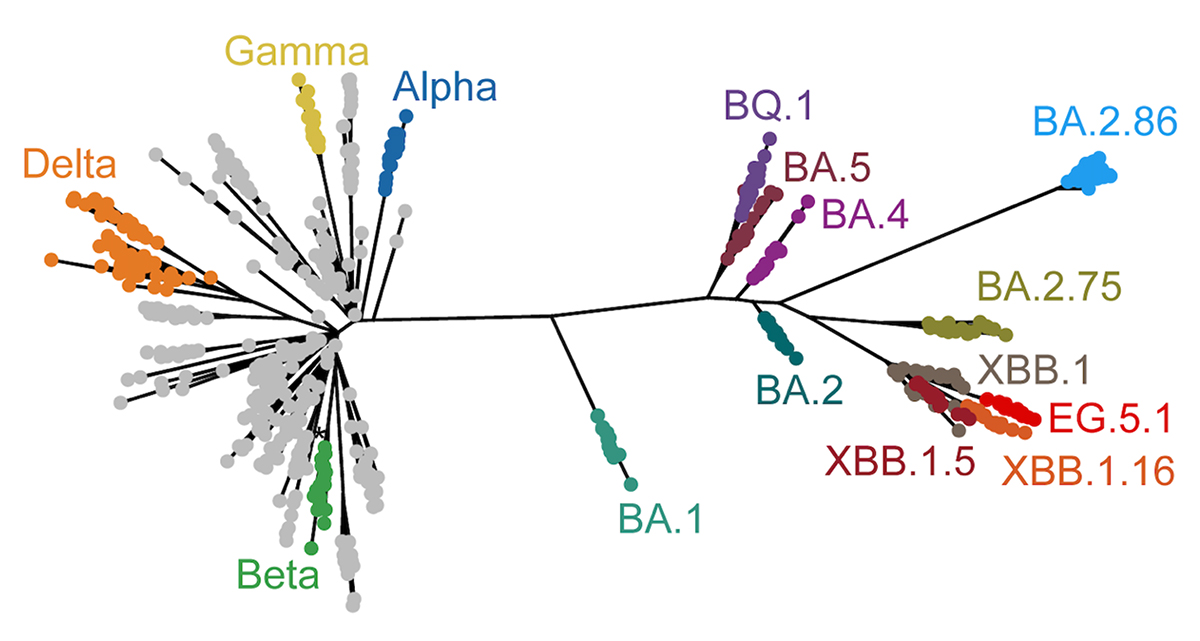
Research Activities
Research Activities
Publications
January 31, 2024
A comprehensive systematic characterization of the SARS-CoV-2 strain BA.2.86
As SARS-CoV-2 XBB descendant strains (mainly EG.5.1) were circulating worldwide predominantly in November 2023, a distantly related strain that emerged a few months earlier began to catch the attention of scientists globally. That strain, BA.2.86, possessed over 30 mutations in the spike (S) protein compared to XBB and its parent strain, BA.2, and was thus assumed capable of evading immunity. As a response, the WHO designated BA.2.86 as a variant under monitoring and a variant of interest in August and November 2023, respectively.
In the recently published study, the researchers first assessed the strain's global epidemic potential and found it to be higher than EG.5.1, the predominant strain at the time. Furthermore, genome surveillance data suggested an upswing in multiple countries around the world. BA.2.86 is now believed to be the dominant strain worldwide.
The research team then focused on the virological properties of BA.2.86, first by examining the ability of its receptor-binding domain (RBD) to interact with ACE2, the principal receptor hijacked by SAR-CoV-2 for cell entry, to determine how its heavily mutated S protein interacts with and infects cells.
Notably, they discovered that the BA.2.86 S RBD binds strongly to ACE2, similar to that of XBB.1.5. Specifically, the R403K substitution that BA.2.86 S RBD possesses substantially enhanced ACE2 binding but only had this effect in the context of BA.2 strains. In parallel, the research team also compared the infectivity of BA.2.86 and other variants. Remarkably, despite gaining over 30 mutations, BA.2.86 showed comparable infectivity to its parental strain, BA.2. Upon analysis of the infectivity by BA.2 variants with individual mutations gained by BA.2.86, it was revealed that while only 6 of those 33 mutations enhance infectivity, 16 have a negative impact.
Next, the researchers examined viral growth by inoculating clinical isolates of BA.2.86 and related strains on different cell lines and organoid model systems. While BA.2.86 interestingly displayed lower replication efficiency in epithelial cells and airway organoids compared to BA.2 and EG.5.1, it exhibited comparable replicative growth as those strains in colon organoids, thus suggesting that viral replication capacity differs between respiratory cells and intestinal cells. Consistent with the observed lower replicative growth in airway organoids by BA.2.86, the ability to penetrate airway epithelial and endothelial barriers was also lower compared to the other SARS-CoV-2 strains examined. The research team also assessed the sensitivity of BA.2.86 to antiviral drugs. As compared to BA.2 and EG.5.1, BA.286 was similarly sensitive to the drugs tested, EIDD-1931, nirmatrelvir, remdesirvir, and ensitrelvir.
Finally, hamsters were intranasally inoculated with clinical isolates of the three SARS-CoV-2 strains to reveal the in vivo characteristics of the BA.2.86 strain. By examining various pulmonary function parameters and body weight loss following infection, BA.2.86 was suggested to be less pathogenic than BA.2 and EG.5.1. Furthermore, it was observed that BA.2.86 infections led to milder effects in infected hamsters upon histological analyses. Consistent with both in vivo and in vitro findings, the in vivo replication efficiency of BA.2.86 was blunted when compared to other strains examined.
In summary, through a series of in vitro and in vivo experiments, the team of researchers comprising the Genotype to Phenotype Japan (G2P-Japan) Consortium performed a comprehensive characterization of an emergent SARS-CoV-2 strain of interest and found its relatively lower pathogenicity can be attributed to a reduced replication capacity. The research team warns that although BA.2.86 appears less pathogenic, we must remain vigilant and continue to monitor the evolution of this new lineage.

Paper Details
- Journal: Cell Host & Microbe
- Title: Virological characteristics of the SARS-CoV-2 BA.2.86 variant
- Authors:
Tomokazu Tamura1,2,3,4,5,6,**, Keita Mizuma7,**, Hesham Nasser8,9,**, Sayaka Deguchi10,**, Miguel Padilla-Blanco11,12,**, Yoshitaka Oda1,4,5,**, Keiya Uriu13,14,**, Jarel E.M. Tolentino13,15,**, Shuhei Tsujino1, Rigel Suzuki1,2, Isshu Kojima7, Naganori Nao2,3,7, Ryo Shimizu8, Lei Wang1,16, Masumi Tsuda1,16, Michael Jonathan8, Yusuke Kosugi13,14, Ziyi Guo13, Alfredo A. Hinay, Jr.13, Olivia Putri13,17, Yoonjin Kim13,18, Yuri L. Tanaka19, Hiroyuki Asakura20, Mami Nagashima20, Kenji Sadamasu20, Kazuhisa Yoshimura20, The Genotype to Phenotype Japan (G2PJapan) Consortium, Akatsuki Saito19,21,22, Jumpei Ito13, Takashi Irie23, Shinya Tanaka1,18,*, Jiri Zahradnik11,*, Terumasa Ikeda8,*, Kazuo Takayama10,*, Keita Matsuno2,3,7,*, Takasuke Fukuhara1,2,3,4,5,6,*, Kei Sato8,13,14,15,*
**: Equal contribution
*: Corresponding authors - Author Affiliations:
- Faculty of Medicine, Hokkaido University
- Institute for Vaccine Research and Development (IVReD), Hokkaido University
- One Health Research Center, Hokkaido University
- Graduate School of Medicine, Hokkaido University
- School of Medicine, Hokkaido University
- Institute for the Advancement of Higher Education, Hokkaido University
- International Institute for Zoonosis Control, Hokkaido University
- Joint Research Center for Human Retrovirus Infection, Kumamoto University
- Faculty of Medicine, Suez Canal University
- Center for iPS Cell Research and Application (CiRA), Kyoto University
- First Medical Faculty at Biocev, Charles University
- Facultad de Ciencias de la Salud, Universidad Cardenal Herrera-CEU, CEU Universities
- The Institute of Medical Science, The University of Tokyo
- Graduate School of Medicine, The University of Tokyo
- Graduate School of Frontier Sciences, The University of Tokyo
- Institute for Chemical Reaction Design and Discovery (WPI-ICReDD), Hokkaido University
- Indonesia International Institute for Life Sciences (i3L)
- Faculty of Natural Science, Imperial College London
- Department of Veterinary Science, Faculty of Agriculture, University of Miyazaki
- Tokyo Metropolitan Institute of Public Health
- Center for Animal Disease Control, University of Miyazaki
- Graduate School of Medicine and Veterinary Medicine, University of Miyazaki
- Graduate School of Biomedical and Health Sciences, Hiroshima University






















